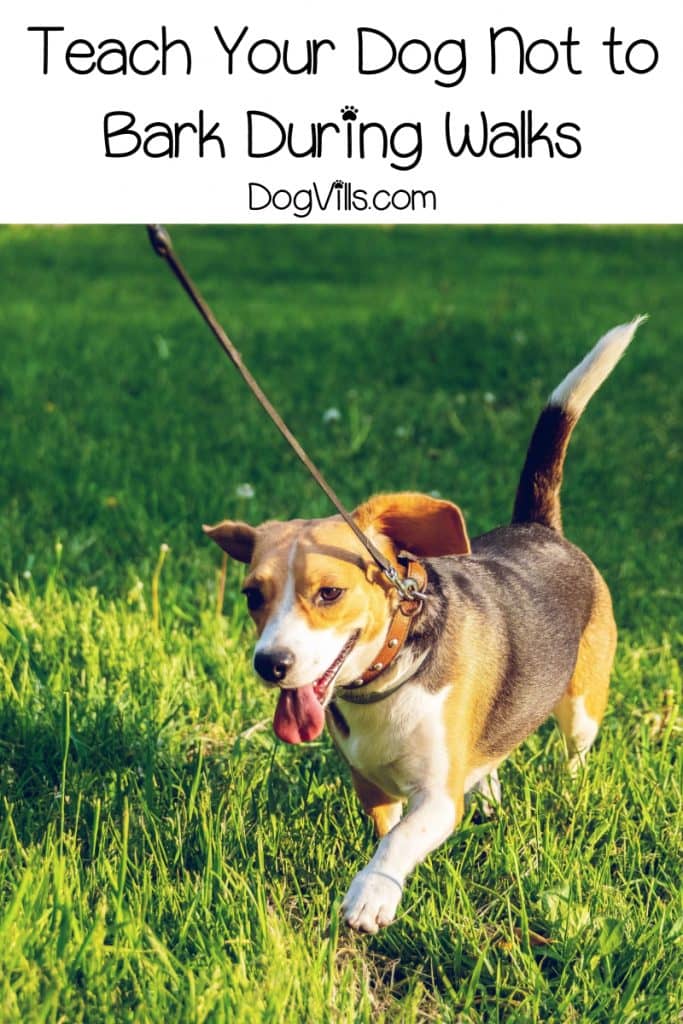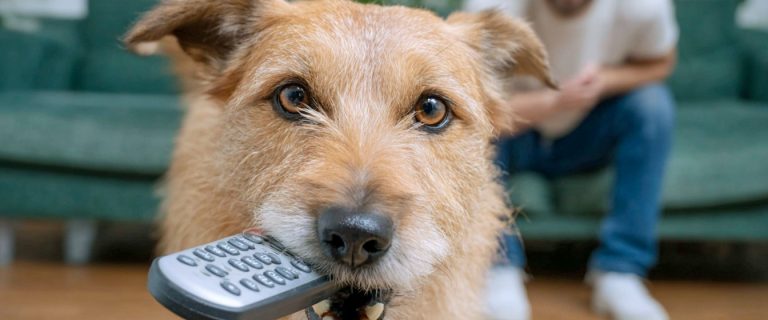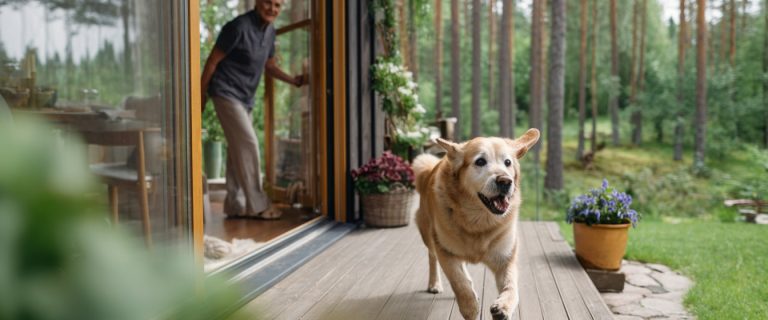Want to learn how to teach a dog not to bark at people and other dogs during walks?
A barking & lunging dog turns the simple pleasure of taking your pup for a stroll into a nightmare.
Fortunately, I’m here to help you overcome this problem.
Just keep on reading.
How to Teach a Dog Not to Bark at People and Other Dogs During Walks

When off the leash, your pooch is friendly and on his best behavior. But once you put the leash on and walk through the door, your dog starts to bark at people and other dogs.
You might have a hard time keeping your dog from lunging and dragging you around.
As a result, you feel embarrassed and out of control. Sounds familiar?
That’s called leash reactivity and is one of the most common problems dog owners face.
However, there are some tricks that will help you deal with it and teach your pooch to be calm around strangers. Then daily walks won’t be a thing to dread.
FYI, this post contains affiliate links. If you make a purchase through these links, we earn a small commission at no extra charge to you.
#1 Understand why your dog is leash reactive
Most people think that barking and lunging dogs are aggressive when they are simply overreacting to stimulus.
What causes a dog to be reactive might be fear, anxiety, frustration, or lack of proper socialization as a puppy.
One of the main reasons for leash reactivity towards other dogs is that dogs are forced to meet head-on and can’t retreat.
Naturally, dogs greet each other from the side and avoid eye contact.
While all the barking might make you think that Rover is looking for a fight, it’s quite the opposite.
If Rover was off the leash, he would run to a safe distance, not attack the other dog. Since Rover can’t do so, he barks to scare off his opponent and prevent a fight.
Sometimes dogs are also reactive because they feel frustrated that they can’t reach their target. That’s a form of barrier frustration.
In addition to this, some dogs express their excitement by barking. So, they might look “aggressive” when they are overexcited.
Lack of proper socialization might also trigger a dog to bark at people/dogs, especially if they look “unusual.”
If you need some help with socializing your dog, the video below is a great place to start.
#2 Determinate your dog’s triggers and threshold
If you have a reactive dog, one of your first business is to determine what triggers your dog.
It might be people wearing hats, children on bikes, or dogs that pass too closely to him.
So, keep an eye during walks and takes notes when your dog starts reacting.
In addition to this, you have to figure out your dog’s threshold. A threshold means the distance between Rover and the trigger.
Under the threshold would be when Rover doesn’t react to the trigger, and over the threshold would be when Rover starts barking, lunging, or jumping.
#3 Get proper leash and harness
Once you’ve established triggers and thresholds, you must think if you have chosen the proper leash for your dog.
You can’t imagine how a no-pull harness can help you in situations where you have to stop your dog from lunging.
It’s also worth mentioning that a harness ensures that your dog won’t hurt its neck if he suddenly lunges at something. Such a harness will also enable you to control your dog better.
If you need a recommendation, the Rabbitgoo Harness has amazing reviews.

Besides a proper harness, you should walk your dog the right way. The dog should keep to your side and never lead the way. Only the leader of the pack chooses the destination, and that’s you.
Moreover, avoid the instinct to tighten your hold on the leash in the presence of people and other dogs.
Despite what you think, a tight leash is not going to make your dog behave or stop struggling.
It has the opposite effect because the dog can feel your tension through the leash and get anxious and stressed.
Take a look at the video below for properly leash-training your dog.
#4 Start desensitizing your dog to his triggers
To stop your dog from barking at people and other dogs, you can desensitize him to his triggers. Here is the easiest way to do it:
- Expose your dog to the trigger but keep Rover under his threshold (he sees the trigger but doesn’t react)
- Feed your dog delicious treats as long as he stays calm in the presence of the trigger. In this way, the dog will build a positive connection with the trigger over time.
- Slowly start to shorten the distance.
- Keep up with the treat when the dog is calm. Stop and retreat if Rover starts reacting.
- Practice often and keep the session short.
While it seems easy and straightforward, this process is going to take time. Don’t expect miracles in a few sessions and be consistent.
#5 Try to avoid triggers
Here’s the thing about dogs. The more a dog reacts to a certain trigger, the more he establishes a negative connotation in his head with the trigger.
Desensitizing is meant to make your dog associate the trigger with positive things like food and treat.
For it to work best, though, you should try to avoid triggering your dog as much as possible.
To avoid triggering your dog, you can:
- Find a place with few or no dogs/people.
- Go for walks at times when you’re less likely to encounter triggers.
- Place a barrier between the dog and the trigger. For example, you can get behind a tree or a car.
- Turn in the opposite direction when you see a dog or a person.
#6 Distract
Unfortunately, it’s not always possible to avoid your dog’s triggers. In such cases, to teach your dog not to bark at people/other dogs, you can try to distract him.
One way to do that would be to use obedience training. Give your dog the “look at me” command and wait for his to respond.
Then you toss your furbaby a treat when he stops barking and does as you say.
In addition to this, you can give your dog a command that Rover can’t do while he is barking.
For example, roll over. In this way, he will have to stop barking to obey you.
You can also use your dog’s favorite toy to distract him from his triggers. However, you should present the toy before Rover reacts. Otherwise, he will see it as a reward for barking.
It’s also possible to toss some treats on the ground while other dogs/people are passing by so that your dog will be too busy eating to bark.
#7 Be consistent
Last but not least, you should be consistent in your training.
If you’re not the only person walking the dog, you should inform the others what to do and how to react in specific situations.
Otherwise, you won’t manage to teach your dog to stop barking at people and other dogs.
Furthermore, you must never resort to yelling or punishing. It will have a negative effect and make your dog more fearful and anxious.
Need a visual guide for how to teach a dog not to bark at people and other dogs during walks? Check out the video below!
9 more tips for walking a reactive dog
Besides the steps I outlined above, here are some more tips to help you walk your reactive dog and avoid confrontations:
- Sudden leash reactivity should be evaluated by a vet. Your dog might be in pain and acting out.
- Stay calm, and don’t be anxious or afraid when you encounter a trigger. Your dog is in tune with our emotions and will act accordingly.
- Teach your dog the basic obedience commands.
- Choose different walking routes so that the dog doesn’t get territorial.
- Add challenges during walks to keep your dog busy.
- Try to keep your dog at a safe distance in the presence of triggers.
- Always carry treats and toys to distract your dog.
- Put a yellow bandana on your dog, so other owners would know they should keep their dog away.
- Consult a professional if your dog’s reactivity escalates.
Leash reactivity in dogs is a problem you must take seriously. While your furbaby is not looking for a fight, Rover might attack if he feels threatened.
If you have any suspicions that your dog might bite or hurt another person/dog, please consult a professional for your furbaby safety.
What do you think about these steps to teach a dog not to bark at people and other dogs during walks? Share your experience in the comments.
Author
-

I’ve grown up surrounded by animals – dogs, cats, cows, goats, sheep, and horses and that has shaped me into what I am today – a crazy cat lady who always has a place for one more cat (or a dog). I’ve got two female cats – Kitty and Roni, and two tomcats – Blacky and Shaggy, but I also feed my neighbors’ cats when they come for a visit. I just can’t say no to them.
View all posts



